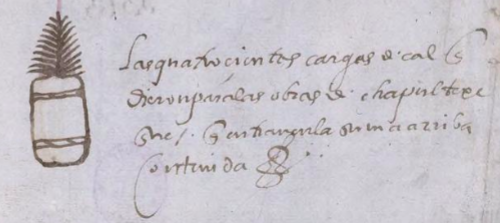tenextli (Osu1v)
This black-line drawing of the simplex glyph of the noun, tenextli (lime) comes from the Codex Osuna, folio 1 verso. It is an upright bundle with rounded edges. It seems to be wrapped in white fabric. Two horizontal lines near the top and bottom are apparently cords or ropes that were used to tie the bundle of lime, which was a tribute item.
Stephanie Wood
In the Codex Mendoza, a bundle of lime is wrapped with a petlatl (woven mat). Small dots above the bundle are an indication that what is inside the bundle is a powdery substance (lime). A kiln for making lime appears as a glyph in the Matrícula de Huexotzinco. See these examples below.
Stephanie Wood
1551–1565
Jeff Haskett-Wood
cal, piedras, cenizas, caliza, construcción, tributos, bultos, paquetes, cargas

tenex(tli), lime, a substance used in stucco, https://nahuatl.wired-humanities.org/content/tenextli
cal
Stephanie Wood
Library of Congress Online Catalog and the World Digital Library, Osuna Codex, or Painting of the Governor, Mayors, and Rulers of Mexico (Pintura del Gobernador, Alcaldes y Regidores de México), https://www.loc.gov/resource/gdcwdl.wdl_07324/. The original is located in the Biblioteca Nacional de España.
"The Library of Congress is unaware of any copyright or other restrictions in the World Digital Library Collection. Absent any such restrictions, these materials are free to use and reuse." But please cite the Biblioteca Nacional de España and this Visual Lexicon of Aztec Hieroglyphs if you use any of these images here or refer to the content on this page, providing the URL.


